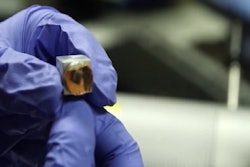Personally, I find doing my laundry to be as unenjoyable of an experience as talking to customer support when my Internet goes out. Luckily for myself and the billions of others who despise folding socks, researchers have developed a system that could eventually clean clothes and other textiles through exposure to light.
Australian University RMIT announced in a Wednesday media statement that its researchers have established a "cheap and efficient" system for growing a unique form of nanostructures into fabrics — nanostructures that they hope could one day result in fabrics that use light to clean itself of stains, dirt and other foul, unsightly substances.
The nanostructures used by the researchers were comprised of copper and silver — elements that absorb light particularly well. When these specialized nanostructures are exposed to light, a charge of energy creates “hot electrons,” which give the nanostructures the ability to breakdown unwanted organic materials.
Dr. Rajesh Ramanathan, a postdoctoral fellow at RMIT’s applied science program, said the breakthrough could impact a number of industries, like agrochemicals or pharmaceuticals, according to the media statement. He also said that the nanostructures could hopefully be created on an industrial scale at some point.
“The advantage of textiles is they already have a 3D structure so they are great at absorbing light, which in turn speeds up the process of degrading organic matter,” he said in the statement. He continued, “There’s more work to do before we can start throwing out our washing machines, but this advance lays a strong foundation for the future development of fully self-cleaning textiles.”
In an effort to assimilate the nanostructures into textiles on an industrial level, the researchers have placed the textiles into nanostructure solutions. This action created “stable nanostructures” in about a half hour. The scientists later exposed the textiles to light and the self-cleaning process started on some of the fabrics in less than six minutes.
“Our next step will be to test our nano-enhanced textiles with organic compounds that could be more relevant to consumers, to see how quickly they can handle common stains like tomato sauce or wine,” Ramanathan said, according to the statement.
The work of the RMIT researchers was published March 23 in the journal Advanced Materials Interfaces.






















